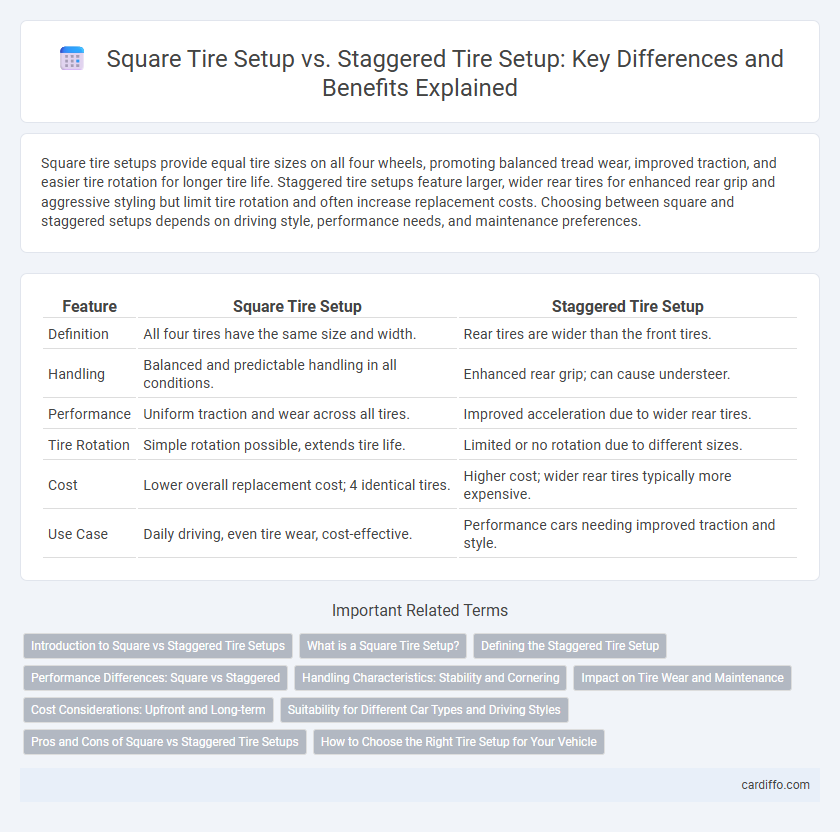Square tire setups provide equal tire sizes on all four wheels, promoting balanced tread wear, improved traction, and easier tire rotation for longer tire life. Staggered tire setups feature larger, wider rear tires for enhanced rear grip and aggressive styling but limit tire rotation and often increase replacement costs. Choosing between square and staggered setups depends on driving style, performance needs, and maintenance preferences.
Table of Comparison
| Feature | Square Tire Setup | Staggered Tire Setup |
|---|---|---|
| Definition | All four tires have the same size and width. | Rear tires are wider than the front tires. |
| Handling | Balanced and predictable handling in all conditions. | Enhanced rear grip; can cause understeer. |
| Performance | Uniform traction and wear across all tires. | Improved acceleration due to wider rear tires. |
| Tire Rotation | Simple rotation possible, extends tire life. | Limited or no rotation due to different sizes. |
| Cost | Lower overall replacement cost; 4 identical tires. | Higher cost; wider rear tires typically more expensive. |
| Use Case | Daily driving, even tire wear, cost-effective. | Performance cars needing improved traction and style. |
Introduction to Square vs Staggered Tire Setups
Square tire setups feature identical tire sizes on all four corners, enhancing uniform grip and simplifying tire rotation for balanced wear. Staggered tire setups use wider tires on the rear axle and narrower ones on the front, optimizing traction and stability, especially for rear-wheel-drive performance vehicles. Each configuration impacts handling dynamics and maintenance strategies tailored to specific driving needs.
What is a Square Tire Setup?
A square tire setup features tires of equal size on all four wheels, optimizing uniform handling, balanced grip, and simplified tire rotation. This setup enhances symmetrical traction and predictable performance, especially in daily driving and track environments requiring consistent tire wear. Square configurations maximize contact patch efficiency, making them ideal for vehicles emphasizing balanced cornering and straight-line stability.
Defining the Staggered Tire Setup
Staggered tire setups feature different tire widths on the front and rear axles, typically wider tires at the rear for improved traction and handling. This configuration enhances cornering stability and acceleration by optimizing grip distribution, especially in rear-wheel-drive vehicles. Square tire setups, by contrast, use identical tire sizes on all four corners, prioritizing even wear and simplified rotation over specialized performance advantages.
Performance Differences: Square vs Staggered
Square tire setups feature identical tire sizes on all four corners, offering balanced grip and predictable handling, which enhances cornering stability and tire wear uniformity. Staggered setups use wider rear tires than the front, improving rear traction for powerful acceleration and better handling in rear-wheel-drive vehicles but may induce understeer during sharp turns. Performance differences highlight square setups as optimal for balanced performance and tire longevity, while staggered setups favor aggressive driving styles requiring enhanced rear-end grip.
Handling Characteristics: Stability and Cornering
Square tire setups with identical tire sizes on all four corners provide balanced handling, improved stability, and predictable cornering behavior due to uniform grip levels. Staggered tire setups, featuring wider tires at the rear, enhance rear traction and cornering grip but may induce understeer and reduce overall steering response. The choice between square and staggered setups depends on a vehicle's drivetrain, intended use, and desired handling dynamics for optimal performance.
Impact on Tire Wear and Maintenance
Square tire setups, where tires on all four corners are the same size and type, promote even tire wear by allowing regular rotations that balance tread wear across all tires. Staggered tire setups, featuring different sizes or widths on the front and rear axles, limit tire rotation options, often resulting in uneven wear patterns and increased replacement frequency on one axle. This imbalance leads to higher maintenance costs and reduced tire lifespan compared to square setups optimized for tire longevity.
Cost Considerations: Upfront and Long-term
Square tire setups, where all four tires share the same size, typically offer lower upfront costs due to uniform tire replacements and simpler maintenance. Staggered tire setups, featuring different sizes on the front and rear axles, often incur higher initial expenses and increased long-term costs due to specialized tire inventory and more frequent replacements caused by uneven wear. Long-term cost considerations also include potential impacts on fuel efficiency and tire rotation limitations inherent in staggered configurations.
Suitability for Different Car Types and Driving Styles
Square tire setups, featuring identical tire sizes on all four corners, provide balanced handling and even tire wear, making them ideal for daily driving and performance cars that require precise cornering and stability. Staggered tire setups, with wider rear tires than front, enhance traction and acceleration in rear-wheel-drive sports cars, benefiting aggressive driving styles and high-horsepower applications where rear grip is critical. Choosing between square and staggered setups depends on vehicle drivetrain, power output, and whether the focus is on neutral handling or maximizing rear traction.
Pros and Cons of Square vs Staggered Tire Setups
Square tire setups use the same size tires on all four wheels, offering balanced handling, easier tire rotation, and cost efficiency due to uniform tire replacements. Staggered setups feature wider tires on the rear axle, enhancing rear grip and cornering performance, but come with higher costs and limited tire rotation options, which can lead to uneven wear. Choosing between the two depends on the priorities for performance, maintenance, and budget in the vehicle's driving conditions.
How to Choose the Right Tire Setup for Your Vehicle
Choosing the right tire setup depends on your vehicle's purpose and performance needs, with square setups providing equal-sized tires on all wheels for balanced wear and enhanced handling in daily driving. Staggered setups feature wider rear tires for improved traction and aggressive cornering, preferred in high-performance and rear-wheel-drive vehicles. Evaluate factors like driving style, vehicle drivetrain, and handling preferences to determine whether a square or staggered tire arrangement best suits your specific requirements.
Square tire setup vs Staggered tire setup Infographic

 cardiffo.com
cardiffo.com